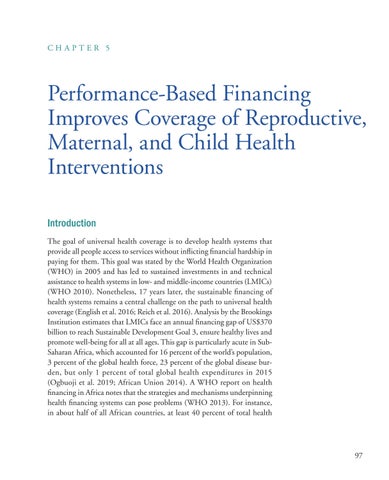CHAPTER 5
Performance-Based Financing Improves Coverage of Reproductive, Maternal, and Child Health Interventions Introduction The goal of universal health coverage is to develop health systems that provide all people access to services without inflicting financial hardship in paying for them. This goal was stated by the World Health Organization (WHO) in 2005 and has led to sustained investments in and technical assistance to health systems in low- and middle-income countries (LMICs) (WHO 2010). Nonetheless, 17 years later, the sustainable financing of health systems remains a central challenge on the path to universal health coverage (English et al. 2016; Reich et al. 2016). Analysis by the Brookings Institution estimates that LMICs face an annual financing gap of US$370 billion to reach Sustainable Development Goal 3, ensure healthy lives and promote well-being for all at all ages. This gap is particularly acute in SubSaharan Africa, which accounted for 16 percent of the world’s population, 3 percent of the global health force, 23 percent of the global disease burden, but only 1 p ercent of total global health expenditures in 2015 (Ogbuoji et al. 2019; African Union 2014). A WHO report on health financing in Africa notes that the strategies and mechanisms underpinning health financing systems can pose problems (WHO 2013). For instance, in about half of all African countries, at least 40 percent of total health
97

